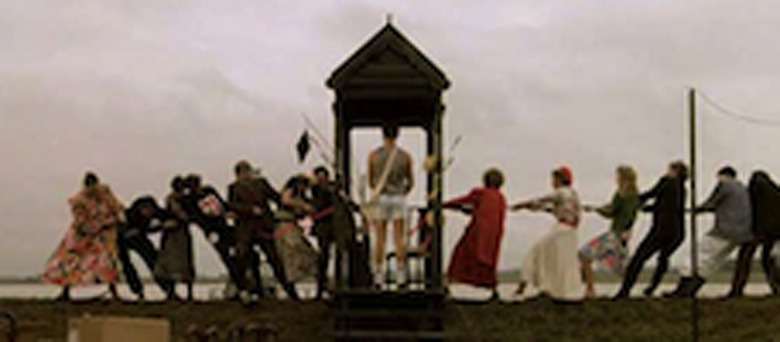Reviews
Peter Greenaway
UK, 1988
Credits
Review by Rumsey Taylor
Posted on 10 July 2004
Source Live Home Video VHS
Drowning By Numbers opens with the image of a girl jump-roping awkwardly in a hoop dress, rhythmically adding a number and corresponding name with each sequential hop. She is counting stars. She ends at a hundred. “100 is enough,” she says to a passer-by. She sits, and the film begins.
It is a stubbornly esoteric opening (perhaps even meaningless), and completely appropriate because it occurs in a Peter Greenaway film. It is the first of many intellectual games seen in the film, described and depicted, as the others, with patient explanation and little debt to the central narrative concerning three identically-named women (each is Cissie Colpitts) and the corresponding murders, all drownings, of their husbands and, for one, boyfriend.
Drowning By Numbers is a curiously feminist film (a persistent theme in Greenaway’s work). Each Cissie is unsatisfied by popularly masculine faults in her male mate: one is an infidel, another is sexually disinterested; both, similarly, are drowned. The final victim is also drowned, this time with little reasoning (conveniently, he is merely unable to swim). It is a cumulative measure in a series of increasingly mystified crimes. The third and final murder is the least specific, done by a woman (the youngest Cissie) who disallows her partner to assume any dominant sexual position. At the point she is to enact her murder in consistent repetition, any procedural details are unnecessary, and the crime serves only a metaphoric purpose. By the third and final murdered male the ability to swim is an apparent superior female trait, and this film is a veiled case of female liberation.
Significantly, this notion of swimming separates men from women. As an omen, water imagery is manifested in the periphery of most every scene. One popular location is below water towers. They are shot to fill the frame, in a visual pun that implies their menace and the threat of water to men. The opening scene, even, is theatrically lit in spurts by a nearby lighthouse; it is a structure of water safety, emblematic here because its warning is unheralded. On a final gesture of ironic humor (a welcome one, given the morbid tone description lends the film), the Colpitts’ toss the crematory urns of their men in a lake, and stare with frustrated surprise as the urns float.
Despite the film’s derogatory view of men (one boy attempts to circumcise himself in a crude surgery that resembles self-castration), it possesses, altogether, a misanthropic view. The Colpitts sisters, in spite of their success at offing their men, are vain and manipulative. Their crimes are kept secret by Madgett, a local coroner, in return for sex. The favor is never reciprocated, Madgett becomes sexually anxious, and the Colpitts see in him the very traits they found off-putting in their men. Each has allowed herself a subsequent opportunity to punish (in the form of declining sexual advances) and eventually murder another male.
Though this narrative fulfills the film’s duration it is with derivative purpose, and the film’s periphery is an intended distraction — active with detail and action. In addition to the games explained, the numbers 1-100 appear in sequence. The first is painted on a tree, the second on a bathtub. Others are merely spoken, and many remain unnoticed. (In multiple viewings I have been persistently unable to locate each one.) It is a countdown that mimics the ancillary function of a VCR timer, manifested aesthetically in the very medium it serves. The technique, while lending the film a playful metaphysical aspect, robs the suspense of the central narrative. By the time “90” appears, if not before, the film’s counting scheme is distractingly apparent; appropriately, the final shot finds “100” on the bow of a sinking dinghy.
Drowning By Numbers is a meticulously organized film. In duration, its depicted games increase in complexity as its murders become increasingly metaphoric. There is also the careful placement and overall clarity of its numbers. Single viewings will reveal the film’s immediate and stubborn inaccessibility (this is a common criticism for Greenaway’s work). It does, however, possess a depth that demands multiple viewings, and it is less likely to alienate viewers than many of Greenaway’s other works. Though not the most visceral of Greenaway’s films (a common trait best exampled in The Cook, The Thief, His Wife and Her Lover), it is a textbook art film, and requisite viewing for obsessive-compulsives.
We don’t do comments anymore, but you may contact us here or find us on Twitter or Facebook.



